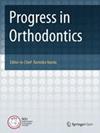Analysis of maxillary asymmetry before and after treatment of functional posterior cross-bite: a retrospective study using 3D imaging system and deviation analysis
IF 4.8
2区 医学
Q1 Dentistry
引用次数: 0
Abstract
Previous evidence would suggest that subjects affected by functional posterior cross-bite (FPXB) present an asymmetric morphology of the maxilla. However, no evidence is available concerning the morphology (symmetry/asymmetry) of the maxilla after treatment of FPXB. This study aimed to investigate the volumetric and morphological changes of the palate in FPXB subjects treated with maxillary expansion and to compare these data with an untreated control group. The study sample included 20 FPXB subjects (mean age 8.1 ± 0.9 years) who underwent maxillary expansion (MEG group) and 21 FPXB subjects (mean age 7.7 ± 1.2 years) as controls (CG group). Digital models were recorded at T0 (first observation) and T1 (12–18 months after first observation) and analyzed to assess palatal volume and symmetry. Deviation analysis and percentage matching calculation were also performed between original and mirrored palatal models for each patient. All data were statistically analyzed for intra-timing, inter-timing and inter-groups assessments. At T0, the cross-bite side (CBS) was significantly smaller than non-cross-bite side (non-CBS) in both groups (p < 0.05). At T1, the CBS/non-CBS difference reduced significantly in the MEG group (p < 0.05) while slightly worsened in the CG, however without statistical significance (p > 0.05). The matching percentage of the palatal models improved significantly at T1 in the MEG group (T0 = 74.02% ± 9.8; T1 = 89.95% ± 7.12) (p < 0.05) while no significant differences were recorded in the CG (T0 = 76.36 ± 8.64; 72.18% ± 9.65) (p > 0.05). The small sample size and the retrospective design of the study represent two limitations that should be overcome with further clinical trials. Subjects with FPXB present an asymmetric development of the maxillary vault that improves after reestablishment of normal occlusion following maxillary expansion.功能性后交叉咬合治疗前后的上颌不对称分析:利用三维成像系统和偏差分析进行的回顾性研究
以往的证据表明,受功能性后交叉咬合(FPXB)影响的受试者上颌骨形态不对称。然而,目前还没有证据表明FPXB治疗后上颌骨的形态(对称/不对称)。本研究旨在调查接受上颌骨扩张治疗的 FPXB 患者上颚的体积和形态变化,并将这些数据与未接受治疗的对照组进行比较。研究样本包括 20 名接受上颌骨扩张治疗的 FPXB 受试者(平均年龄为 8.1 ± 0.9 岁)(MEG 组)和 21 名作为对照的 FPXB 受试者(平均年龄为 7.7 ± 1.2 岁)(CG 组)。记录 T0(首次观察)和 T1(首次观察后 12-18 个月)时的数字模型,并对其进行分析,以评估腭部体积和对称性。还对每位患者的原始腭部模型和镜像腭部模型进行了偏差分析和百分比匹配计算。对所有数据进行了定时内、定时间和组间评估的统计分析。在 T0 时,两组患者的交叉咬合侧(CBS)明显小于非交叉咬合侧(non-CBS)(P 0.05)。在 T1 阶段,MEG 组的腭模型匹配率明显提高(T0 = 74.02% ± 9.8;T1 = 89.95% ± 7.12)(P 0.05)。该研究的样本量小和回顾性设计是两个局限性,应在进一步的临床试验中加以克服。FPXB患者的上颌穹隆发育不对称,在上颌扩容后恢复正常咬合后,这种情况会有所改善。
本文章由计算机程序翻译,如有差异,请以英文原文为准。
求助全文
约1分钟内获得全文
求助全文
来源期刊

Progress in Orthodontics
Dentistry-Orthodontics
CiteScore
7.30
自引率
4.20%
发文量
45
审稿时长
13 weeks
期刊介绍:
Progress in Orthodontics is a fully open access, international journal owned by the Italian Society of Orthodontics and published under the brand SpringerOpen. The Society is currently covering all publication costs so there are no article processing charges for authors.
It is a premier journal of international scope that fosters orthodontic research, including both basic research and development of innovative clinical techniques, with an emphasis on the following areas:
• Mechanisms to improve orthodontics
• Clinical studies and control animal studies
• Orthodontics and genetics, genomics
• Temporomandibular joint (TMJ) control clinical trials
• Efficacy of orthodontic appliances and animal models
• Systematic reviews and meta analyses
• Mechanisms to speed orthodontic treatment
Progress in Orthodontics will consider for publication only meritorious and original contributions. These may be:
• Original articles reporting the findings of clinical trials, clinically relevant basic scientific investigations, or novel therapeutic or diagnostic systems
• Review articles on current topics
• Articles on novel techniques and clinical tools
• Articles of contemporary interest
 求助内容:
求助内容: 应助结果提醒方式:
应助结果提醒方式:


